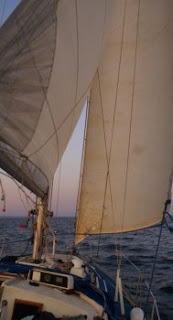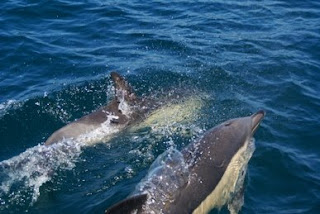The fay after we arrive at Peniche was going to be windy and so we decided to rest and sort out the Marina place. Telma was leaving as well, so I decided to stay in Port. The Marina problem was sorted very easily. I was told by the port officials to go to "Clube Naval" of Peniche and ask for a place on the inside of the Marina. There I talked to Sra. Antonieta who was simply impeccable. She did all she could to find us a better place, and eventually did. So, in the middle of the afternoon, we moved to a place where we could have an electric plug guaranteed. I also took the chance to buy some stuff I needed for the boat,namely a new mooring cable for the stern of the boat, and a new stern light that was stolen from us in Porto Marina. The rest of the day was pretty much spent resting. Next day me and Pedro would be going out to try and start sampling. We had done it before, so we would do it again.
Next day we went out with nice weather and some mild wind. The number of
herring gulls lying in the waters outside the port was impressive.
Herring gulls nest in Berlengas, and due to the lack of predator their numbers grew exponentially. They are now considered a plague in Peniche, but all efforts to contain their numbers have been largely unsuccessful. We set course to a place were me and 1st mate saw dolphins when coming up. When we were approaching that point I went to the bow and started looking for dolphins.Soon, a groups of 5 was in sight, right in the exact same place we saw them earlier! I prepare the gear to start sampling. I waited patiently for my chance. I soon get a clean shot and fire a perfect one... a perfect sample was coming on the dart! I process the sample and prepare for the second shot. Again, success! Things were looking good. By lunch time we had collected 4 samples. However we lost the dolphins and we decided to have lunch while searching for them further West.
 Pedro taking the helm with Farilhões in sight, one of the islands that are part of Berlengas archipelago.
Pedro taking the helm with Farilhões in sight, one of the islands that are part of Berlengas archipelago.
 Close-up of Farilhões
Close-up of FarilhõesAt some point I decided to come back closer to shore and found dolphins pretty much in the same place we left them. "So that's where they were!!" I commented. I restarted sampling. Shot after shot I was getting some perfect samples and dolphins didn't seem to mind at all. At some point the wind increased slightly, but we were doing so good that I didn't even realized it. We stopped at 9 samples and only because I didn't want to risk and make the dolphins suspicious. It was hard for me to believe, after all the difficulties we faced in Porto and Figueira, that this was going so smoothly. In the end, I started taking pictures of their dorsal fins to add to our catalogue.


Every time a crew member comes back to Clavadel, I feel a cycle is complete. On one hand it's like, the experience was good enough for them to want to come back, and on the other is like Clavadel is starting to build is own stable crew. It happened first with Zé and Nef, coming back this year after last year work, and this year with Telma and Ana. The first day we sampled Zé came back again for the third time, making him the most regular and stable crewmember. In the end of the week, 1st mate would be coming back as well for a week to help with fieldwork. There are happy days in the life of a dolphin researcher after all!!!!! :)
When I told Zé I had just came back from the first day with 9 samples he couldn't beleive it. "That means..." "Yes!" I stopped him "It's the record of the most samples obtained in a single day since the beginning of the project! And all in the first day we went out in a given place.". "Man, we're going to finish Peniche in no time!". "Don't celebrate before the end, we still have 20 more to collect." I advised cautiously. I learned not to be too optimistic al in this work, it is most likely that you'll end up deeply frustrated!
Second day of sampling in Peniche was definitely the toughest, but also the most rewarding. Although we started out with good weather, the threatening front we were seeing n the horizon soon approached us. We were still able to get a couple of samples before it reached us, but Berlengas were soon covered. "Is that fog or rain?" I asked Zé. "I think it's fog". "Shit!!! I think it's rain... I hope it's rain!".


It was rain indeed, and soon we had only a couple of miles of visibility. Mild rain soon became pouring rain and my trousers were soon soaked. Dolphins were around though, and I couldn't afford the luxury of stopping. Aiming was harder than ever. I had to keep my sunglasses to eliminate the reflection of the water and aim more effectively, but that meant that, besides my best efforts, they were soon soaked as well. Adding to that, the drops of rain falling in the sea, made the surface fuzzy and so hard to spot the dolphins. At sample number 8, I decided to change my trousers for the waterproof ones. Back in business, I was now the only one staying on the bow. At some point I started hearing some loud screams. As I look up to see what it was, I see a small
RIB full of people all hysterical because of the dolphins. What was a small boat like that venturing so far out to sea in a day like that. I was already a bit upset to have to sample in that weather, so having a boat nearby really was the last thing I wanted. I effusively "ask" them to leave, which they did. Not sure if because of me, but it worked anyway! I stopped at 11 samples! It was the absolute record of samples obtained on one day. As we were coming back, weather started to improve until it was sunny again! Zé commented "This is just so that people in port will look at us and think: look how lucky those guys are, going out on a sailing boat in such a great weather like this!!!". It was ironic that rain had started exactly in the moment we started sampling, and cleared when we finished.


The two successful says meant we only needed 10 more samples before we could leave Peniche. Given our first days, I was becoming increasingly more confident it was possible. I went to bed early to save my strengths for the next day. It would be a decisive one. A successfull day meant we could still move to
Sines and try and complete sampling there before the end of August. It would also turn this into a highly successful fieldseason, irrespectively of how many samples we were able to collect in Sines.
The next day I wake up early but only to find the port covered in fog. In the present conditions, no wind meant a front was passing through and fog was likely to settle. My hopes were being shattered. We waited far a while for the fog the lift but it was proving hard. We chated about almost everything to distract us from the waiting. Eventually we got tired and I reckoned the fog was lifting. Zé agreed so I just decided to leave. If it was too bad, we could always come back. As we left port the fog wasn't much better, but we could navigate safely. However, as soon as we crossed cape Carvoeiro, the fog lifted and we were facing the most calm sea with a deep blue sky above. We were ready to start sampling. Little by little, the number of samples increased. I had to be careful not to sample the same individuals twice, as I could recognize them and see them surfacing in my line of sight. Eventually there was only one left. I aim... I get a clear shot... and I shoot. "Done!!! Sample number 30 from Peniche is done. Let's go home!" Dolphins kept bowriding, so we took pictures of their fins. Eventually we were done, and I took the chance to just watch the dolphins bowriding. As I leaned on the bow, I could hear them vocalize and I wondered what could those sounds mean!
We were done. In 3 days, me Pedro and Zé collected all the samples we needed from Peniche. Nice weather, dolphins exhibiting the perfect behaviour and the new sampling system allowed us to do the most successful sampling ever since the beginning of this work. The only thing that crossed my mind then was the famous quote by Winston Churchill:
"We shall not fail or falter; we shall not weaken or tire... Neither the sudden shock of battle nor the long-drawn trials of vigilance and exertion will wear us down. Give us the tools and we will finish the job."




























































